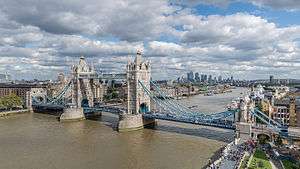City Hall, London
| City Hall | |
|---|---|
 City Hall | |
 Location of City Hall in Central London | |
| General information | |
| Address |
The Queen's Walk London, SE1 United Kingdom |
| Coordinates | 51°30′17″N 0°04′42″W / 51.50472°N 0.07833°W |
| Current tenants | Greater London Authority |
| Completed | 2002 |
| Owner | More London Development Ltd. |
| Height | 45 m[1] |
| Design and construction | |
| Architect | Norman Foster |
| Architecture firm | Foster and Partners |
| Structural engineer | Arup |
| Website | |
|
www | |
City Hall is the headquarters of the Greater London Authority (GLA), which comprises the Mayor of London and the London Assembly. It is located in Southwark, on the south bank of the River Thames near Tower Bridge. It was designed by Norman Foster and opened in July 2002, two years after the Greater London Authority was created.
Background
For the first two years of its existence, the Greater London Authority was based at Romney House, Marsham Street in Westminster.[2] Meetings of the London Assembly took place at Emmanuel Centre, also on Marsham Street.[3]
City Hall was constructed at a cost of £43 million[4] on a site formerly occupied by wharves serving the Pool of London. The building does not belong to the GLA but is leased under a 25-year rent.[5] Despite its name, City Hall is not in and does not serve a city (according to UK law), which often adds to the confusion of Greater London with the City of London, which has its headquarters at Guildhall. In June 2011, Mayor Boris Johnson announced that for the duration of the London 2012 Olympic Games, the building would be called London House.[6]
The predecessors of the Greater London Authority, the Greater London Council and the London County Council, had their headquarters at County Hall, upstream on the South Bank. Although County Hall's old council chamber is still intact, the building is unavailable for use by the GLA because of its conversion into, among other things, a luxury hotel, amusement arcade and aquarium.
Design


The building has an unusual, bulbous shape, purportedly intended to reduce its surface area and thus improve energy efficiency, although the excess energy consumption caused by the exclusive use of glass (in a double facade) overwhelms the benefit of shape. Despite claiming the building "demonstrates the potential for a sustainable, virtually non-polluting public building",[7] energy use measurements have shown this building to be fairly inefficient in terms of energy use (375 kWh/m2/yr), with a 2012 Display Energy Performance Certificate rating of "E".[8] It has been compared variously to Darth Vader's helmet, a misshapen egg, a woodlouse and a motorcycle helmet. Former mayor Ken Livingstone referred to it as a "glass testicle",[9][10] while his successor, Boris Johnson, has referred to it as "The Glass Gonad"[11] and more politely as "The Onion". Its designers reportedly saw the building as a giant sphere hanging over the Thames, but opted for a more conventionally rooted building instead. It has no front or back in conventional terms but derives its shape from a modified sphere.
A 500-metre (1,640 ft) helical walkway, based on that used in the cupola of the Reichstag building in Berlin, ascends the full height of the building. At the top of the ten-storey building is an exhibition and meeting space called "London's Living Room", with an open viewing deck which is occasionally open to the public. The walkway provides views of the interior of the building, and is intended to symbolise transparency; a similar device was used by Foster in his design for the rebuilt Reichstag (parliament) in Germany. In 2006 it was announced that solar photovoltaic cells would be fitted to the building by the London Climate Change Agency.
The council chamber is located at the bottom of the helical stairway. The seats and desks for Assembly Members are arranged in a circular form with no clearly defined "head", podium, or chair where a speaker, council chairperson, or mayor might be seated. Raised tiers of seats for visitors or observers is located to one side.
Location

The building is located on the River Thames in the London Borough of Southwark. It forms part of a larger development called More London, including offices and shops. Next to City Hall is a sunken amphitheatre called The Scoop, which is used in the summer months for open-air performances; it is not, however, part of the GLA's jurisdiction. The Scoop and surrounding landscape were designed by Townshend Landscape Architects. The nearest London Underground and National Rail station is London Bridge.
References
- ↑ City Hall on Emporis.com
- ↑ "Greater London Authority – Press Release". Legacy.london.gov.uk. 15 March 2001. Retrieved 2012-08-15.
- ↑ "London Assembly meeting – 24 May 2000". Legacy.london.gov.uk. Retrieved 2012-08-15.
- ↑ "SPICe Briefing" Retrieved on 2010-03-01
- ↑ "Inside City Hall" Retrieved 2010-03-01
- ↑ London SE1 website team London SE1 community website. "City Hall to be renamed ‘London House’ during 2012 Olympics [15 April 2011]". London-se1.co.uk. Retrieved 2012-08-15.
- ↑ http://www.fosterandpartners.com/projects/1027/default.aspx
- ↑ Peter Macdiarmid/Getty Images. "Public building CO2 footprints revealed". the Guardian. Retrieved 14 September 2015.
- ↑ Deyan Sudjic (8 July 2001). "A thoroughly modernising mayor". The Observer. Retrieved 23 January 2010.
- ↑ "Inside London's new 'glass egg'". BBC News. 16 July 2002. Retrieved 23 January 2010.
- ↑ Stephen Robinson (28 December 2008). "Is Boris on an upward spiral at last?". The Sunday Times. Retrieved 23 January 2010.
External links
| Wikimedia Commons has media related to City Hall (London). |
Coordinates: 51°30′17″N 0°04′42″W / 51.50472°N 0.07833°W